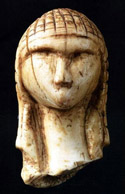Anthropology, Department of

Department of Anthropology: Faculty Publications
Document Type
Article
Date of this Version
2-24-2016
Citation
Draft report submitted as partial fulfillment of CESU Master Agreement P14AC00979, Project Number: UCOB-109 to Chaco Culture National Historical Park, New Mexico by the University of Colorado, Boulder, Colorado
Abstract
The Colorado Plateau is a land of long horizons punctuated by dramatic buttes, mesas, and mountain ranges. The rich cultural heritage and natural beauty of this region hold meaning for the millions of tourists who visit each year to experience this iconic landscape. Many of these same places on the Plateau are still considered central to indigenous religious practices, histories, and oral traditions of descendent communities in the region. This landscape is also defined by the complex connections and histories of diverse resident communities. Ancient communities of the Plateau are the focus of ongoing major anthropological investigations into such issues as Neolithic demography and agriculture, emergent sociopolitical complexity, and human impact on the environment. In short, Chacoan archaeology has many stakeholders.
Chaco Canyon is a UNESCO World Heritage Site, important not only for contemporary indigenous peoples and archaeologists but for all of humanity. It preserves a unique aspect of the human experience and draws over 40,000 visitors yearly to witness its grandeur and Native history. The confounding aspect of this cultural chapter is precisely its scope and formal expression across such a vast landscape. It was not until the 1970s that archaeologists fully grasped the extent of the ancient Chacoan roadways and thus the scope of the Chaco world. Forty years later, we are still struggling to understand this spatial and temporal complexity, trying to determine the connections and human experiences of those who built and traversed these roads, great houses, shrines, and kivas.
Chaco was not a single locality, nor was it merely a series of discrete localities or elements; management decisions that reduce this landscape to dots on a map threaten to destroy the most compelling, least-understood, and perhaps most significant aspect of this phenomenon. A century of research has shown that Chaco was comprised of relationships and shared symbols. Our ability to resolve many of the remaining research issues outlined above depends upon the protection of this landscape in a way that honors both what is known and what we still have to learn.
The goal of this paper is to provide an academic overview regarding the Chaco landscape: what it is, what we know about it, how we know what we know, and what we still have to learn. The purpose is to provide a comprehensive tool that can be used for management purposes. The text provides a summary road map while appendices to this document contain supporting information and broader discussions. The paper is divided into 7 sections: (1) introduction to Chaco in time and space; (2) management history and considerations; (3) landscape theory; (4) defining the Chaco landscape, part one – the material elements; (5) research issues; (6) defining the Chaco landscape, part two – the experiential elements; and (7); concluding arguments. In the main body of this paper we lay out our primary points; supporting data and additional discussion for each section is found in corresponding appendices.
Included in
American Material Culture Commons, Archaeological Anthropology Commons, History of Art, Architecture, and Archaeology Commons, Indigenous Studies Commons, Social and Cultural Anthropology Commons


Comments
This paper, informally termed the “White Paper,” presents current anthropological theory, methods, and research on Chacoan landscapes at several scales. The paper consists of 17 pages of text which summarize anthropological and management issues, supported by 45 pages of Appendices and a list of References cited. A condensed set of “Management Considerations” is presented in Section VIII of the text.